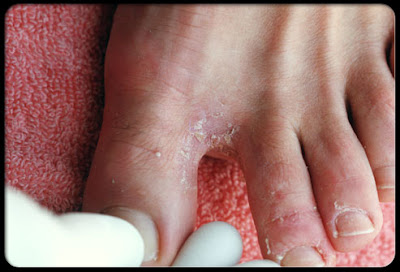Athletes Foot - What Is It All About?

Athlete's foot was first discovered early in the 19th century.
Initially the belief at the time was that it was caused by bug bites.
This belief was proven to be untrue. Dermatophytes are the primary cause
of athlete's foot. Dermatophytes were discovered in the 19th century.
Dermatophytes affect the top layer of skin. It goes by different names
such as microorganism, fungus, dermatophyte, ringworm and tinea. A
fungus can live off the skin of the body. Dermatophytes in the case of
athlete's foot affects the skin of the feet.
Tinea is a skin
problem that affects people at least once in their lifetime. Tinea is a
parasitic fungal infection. Tinea can grow on different parts of the
body. It can develop on the feet, groin, scalp, face, nails, and hands.
Tinea cruris is also called jock itch. Jock itch is a common growth in
the groin area. Tinea can be extremely itchy.
Athlete's foot may
appear differently for different people. The skin can be dry and scaly
affecting the area between the toes and the sole of the foot. Athlete's
foot can start out as a rash and progress to blisters. This fungal
disease can appear as a whiteish yellow rash with bright red blisters.
The toenails may be infected. The skin may become sensitive to touch,
there may be a burning sensation. The feet may have a bad odour. The
feet may have a watery discharge.
Preventing tinea is easy. When
showering in public gyms always wear water sandals to avoid coming into
contact with the fungus. The foot fungus grows in wet hot areas. Give
your feet a chance to breath by wearing another pair of sandals at home.
Do not share towels. Change socks frequently.
When animals such
as cats and dogs acquire athlete's foot it is called ringworm. Human
beings can get athlete's foot from animals.
There are many
different remedies for the different types of tinea. It is important to
develop a treatment plan and stick to it. Feet should be kept dry and
clean. There are different topical applications for tinea. They come in
creams, sprays or powders. There are also athlete's foot home remedies.
Tea tree oil is a popular home remedy. A mixture of apple cider vinegar
with water is a common natural treatment. Whatever treatment you choose
stick to the routine for a couple of months to ensure the fungus is
completely gone.
Article Source:
http://EzineArticles.com/?expert=Krista_M_Kisiw











0 comments:
Post a Comment